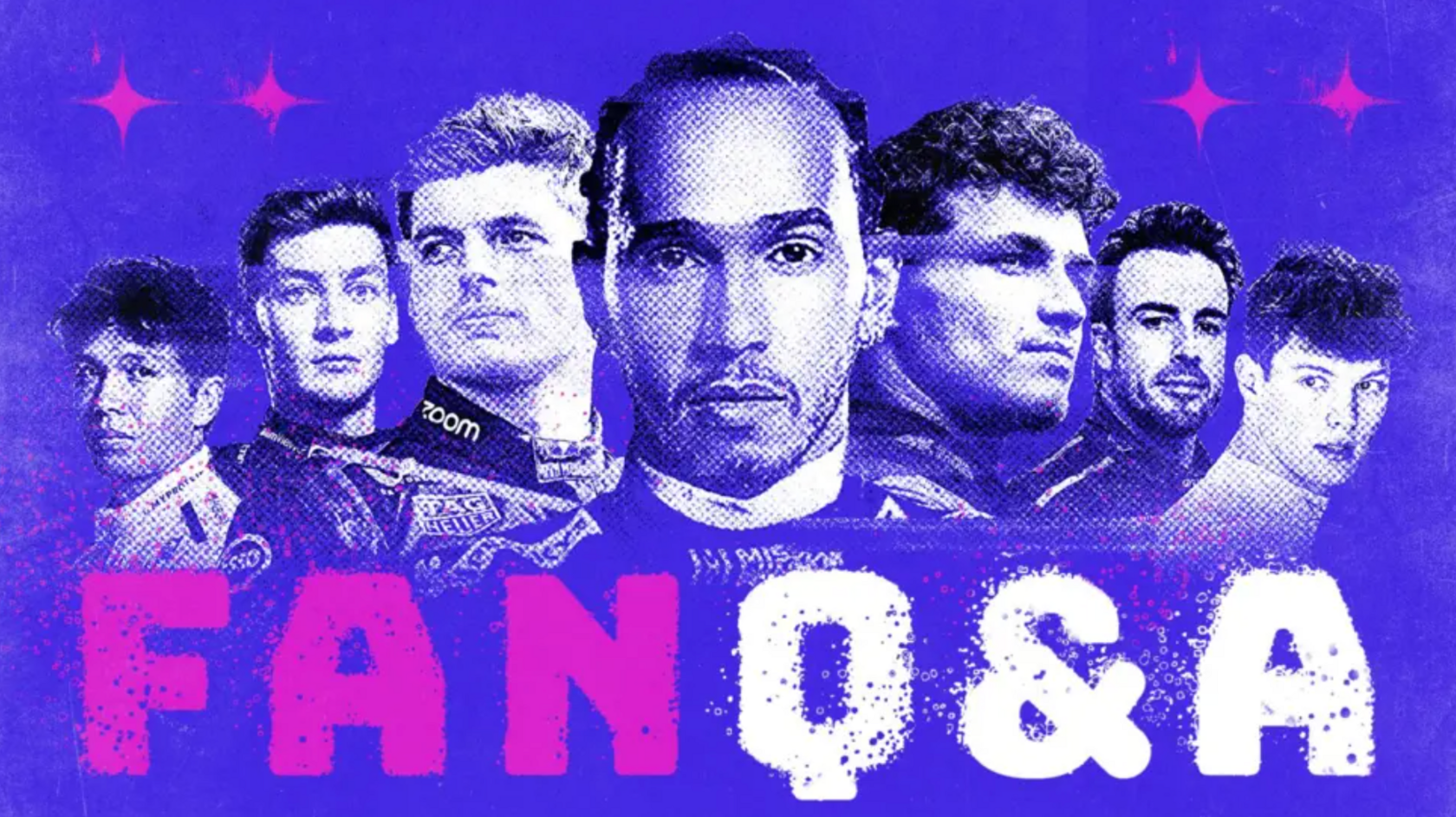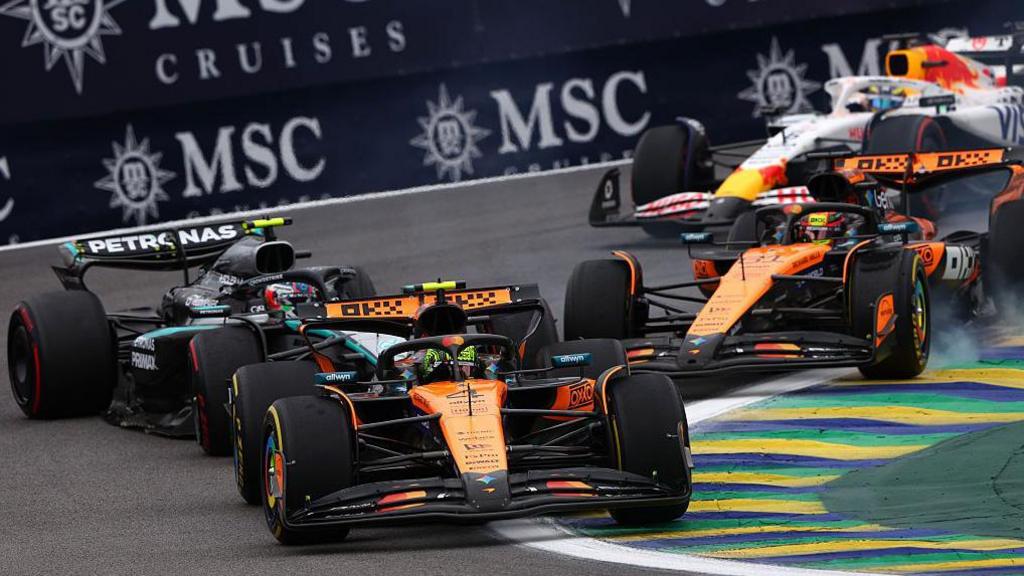 Image source, BBC Sport
Image source, BBC Sport
Lando Norris executed a perfect weekend at the Sao Paulo Grand Prix on Sunday to extend his title lead over McLaren team-mate Oscar Piastri to 24 points.
The Briton took 33 points in total at Interlagos by winning both the sprint race and grand prix, while Australian Piastri failed to make the main podium for the fifth weekend in a row and finished fifth.
Max Verstappen's third place after starting from the pit lane also caught the eye, but the four-time title winner is now 49 points behind leader Norris.
With only three races and one sprint event left of the 2025 season, BBC F1 correspondent Andrew Benson answers your latest questions.
Do you think the stewards were being harsh on Oscar Piastri in giving him a 10-second penalty for his part in the collision with Kimi Antonelli and Charles Leclerc, when most other people thought it was a racing incident? - Andrew
It's easy to see why Piastri was penalised for the incident, when you read the FIA's driving standards guidelines.
They say that to be entitled to be given room when overtaking on the inside, the overtaking car must:
"Have its front axle at least alongside the mirror of the other car prior to and at the apex; and be driven in a fully controlled manner particularly from entry to apex, and not have 'dived in'."
Although Piastri was almost fully alongside Antonelli on the pit straight and entering the braking zone, his front axle was no longer alongside the mirror of Antonelli's car at the apex.
He also locked up his front left tyre, which presumably gave the stewards the impression that he was not "fully controlled".
The stewards report said Piastri "did not establish the required overlap prior to and at the apex" and "locked the brakes as he attempted to avoid contact by slowing, but was unable to do so and made contact". They concluded that Piastri was "therefore wholly responsible for the collision".
So, yes, the guidelines say the penalty was justified.
But was it right?
 Image source, Getty Images
Image source, Getty Images
Behind leader Lando Norris, the Mercedes of Kimi Antonelli has just been knocked off line after contact with Oscar Piastri
The problem with the guidelines is that they are being applied to the letter, without what some would consider giving proper consideration to the reality of racing.
If a driver is almost fully alongside another car heading to the braking zone, they are absolutely entitled to make the move. And the guidelines imply that, too.
On the inside, a driver has to brake earlier because of their narrow trajectory, so the relative position of the cars will change on corner entry. This is especially the case if the track is still slightly damp after rain.
Should that mean the driver is not entitled to be given room? Should they be required to back out at this point? Is that even feasible? Should it mean the driver should not go for the move in the first place?
There is an argument that Antonelli knew Piastri was on the inside, and would have been wise to give him more space, rather than cut in towards the apex so much and risk contact.
In this case, Charles Leclerc, who was taken out by Antonelli after the collision between Piastri and the Italian, said: "Oscar was optimistic, but Kimi knew that Oscar was on the inside, I think, and he kind of did the corner like Oscar was never there.
"For me, the blame is not all on Oscar. It was optimistic, but this could have been avoided. I wouldn't go as far to say it's all of Oscar's fault. I don't think it is."
Piastri said: "I had a very clear opportunity up the inside, went for it. Yes, there was a lock-up, but I was firmly on the apex, on the white line. I couldn't go any further left, and I can't just disappear."
Antonelli said: "I found myself in a very difficult position because I had one car on the outside and one car on the inside. I tried to brake late, not too late. The problem is I didn't see the car next to me any more. I still tried to do a decent line for the position I was in. And, yeah, ended up getting hit."
Ultimately, these are subjective questions on which opinions will vary.
What can be said for certain is the drivers, as a general overview, are not that happy with the guidelines, or the manner in which they are being applied. This has come up time and again this year. It does seem like some kind of review is required.
Could the new 2026 regulations be Lewis Hamilton's saving grace? And if Ferrari get the car wrong again, what's the risk of Charles Leclerc and Hamilton moving on to different teams? - Laura
Lewis Hamilton had another difficult race in Brazil.
He qualified 13th while team-mate Charles Leclerc was third. Hamilton was hit by Carlos Sainz at the first corner, damaging his car, and then misjudged a passing move on Franco Colapinto's Alpine at the start of the next lap and took off his own front wing.
After what has undoubtedly been a difficult maiden season at Ferrari, it's little wonder that he said afterwards: "This is a nightmare, and I have been living it for a while."
Hamilton went on to say: "I believe there is something extraordinary up ahead in my life and in my destiny. I truly still believe in this team and what we can achieve together."
In terms of his overall form, there is no question that Hamilton has improved as the season has gone on - since the summer break, he is down only 0.099 seconds on average on Leclerc in qualifying. That number is 0.128secs for the year.
At the same time, Hamilton has made no secret of the fact that he does not really get on with the current era of cars. They don't suit the way he likes to brake late and pitch the car into the corner, and he hopes the 2026 cars, following the introduction of new rules, will be better suited to him.
As for his future, Ferrari have not said how long his contract is. But I have been hearing for a while that Hamilton is on a firm three-year deal at Ferrari - ie, to the end of 2027 - and an exchange he had with the media in Brazil did seem to confirm this.
He was asked when he expected to start negotiations on a new contract, and he replied: "I have a pretty long contract. Normally, when you do a contract, it's usually the year before (it ends) you start to talk about it. I'm a little bit far from that right now."
He was asked whether that meant he would be doing so next year, and he replied: "No."
The length of Leclerc's contract has not been officially revealed by Ferrari, but it is said to run until 2029. Of course, there may be options in there that could see him leave earlier.
Max Verstappen's drive in Sao Paulo was quite reminiscent of Lewis Hamilton in 2021, the common theme being they had a new engine. Is Brazil a track where this has a greater impact than others? Should other drivers consider it as an out-there strategy call, or was it only possible because of the huge talent of those two drivers? - Tom
It's extremely rare that a driver can achieve this sort of a result after starting from the pit lane. Verstappen's achievement in Brazil matched those of Jarno Trulli in Australia in 2009, Sebastian Vettel in Abu Dhabi in 2012 and Lewis Hamilton in Hungary in 2014.
A new engine definitely gives a small performance advantage, but Verstappen's drive on Sunday was much less to do with than two other things - Red Bull's change to the car's set-up, and Verstappen's own genius.
The fact that he did it after being dropped to the back again by his pit stop for a puncture on lap six, having already climbed to 13th, was all the more impressive.
Having said that, it's not all that rare for a driver who has qualified badly to make a pit-lane start, as it means changes can be made to the car with the intention of making it faster in the race.
That's exactly the strategy Red Bull employed in Sao Paulo.
But the difficulty of overtaking in F1, and the fact that very few drivers could have achieved what Verstappen did, means it's highly unlikely to become a strategic option outside those specific circumstances.
A Mercedes customer team has comprehensively beaten the works team for two years in a row. If McLaren start next season still ahead of Mercedes, at what point does it start to be a real problem for the works team? - James
Mercedes obviously don't ever want to be beaten by McLaren, and certainly don't want it to keep happening. They want to win themselves.
But motorsport director and F1 team principal Toto Wolff always says when asked about this that if Mercedes can't win, the next team he would want to do so would be a Mercedes customer, because at least then Mercedes are still winning.
McLaren's success has helped ensure Mercedes-powered cars have won all but two of the constructors' titles since the start of the hybrid era in 2014, missing out only in 2022 and 2023, when Red Bull-Honda were at their most dominant.
McLaren beating the works team can't make Wolff's life that comfortable, but Mercedes do not give the impression that this is an existential question for them.
Their presence in F1 is based on the fact that they believe the investment is rewarded by the publicity value of having a competitive team, in concert with the technological benefits for the whole company of being at the forefront of motorsport.
It's also worth saying that supplying engines to customers makes money for Mercedes and helps offset the research and development costs of their F1 engine programme. In total, it made them about £90m last year, taking into account fees for engines and dividends.
Mercedes have been in F1 for more than 30 years, regardless of whether you pick their formal works entry with McLaren in 1995 or their "concept by Mercedes" branding with Sauber in 1993 as their starting point. And they are in it for the long haul.
Get in touch
Send us your question for F1 correspondent Andrew Benson

 3 hours ago
2
3 hours ago
2

















































